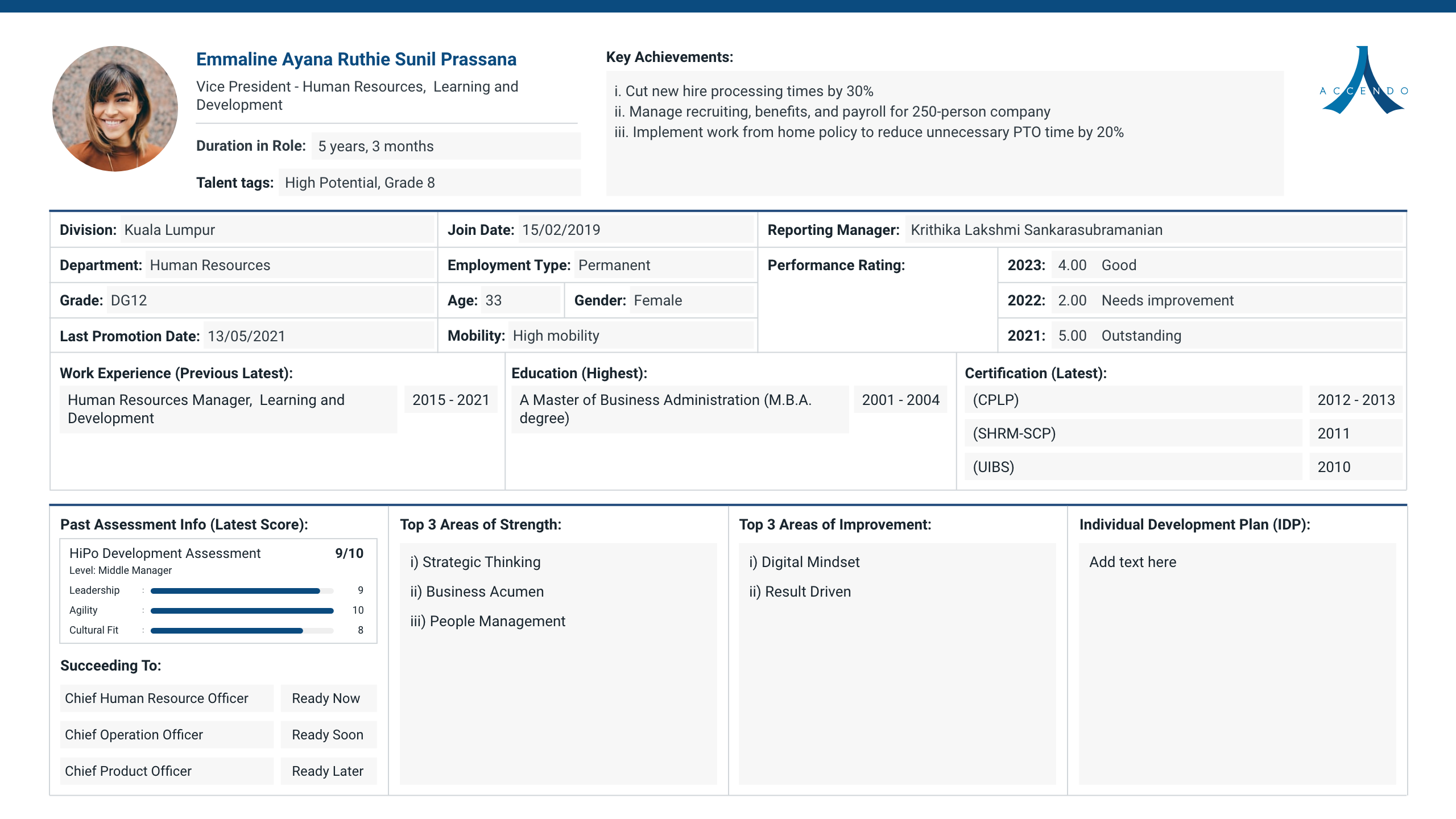
Succession planning is vital for organisations in today’s competitive business landscape. This blog outlines its importance, the five key benefits, and various approaches. Technology-based solutions like digital platforms and HRMS systems offer efficiency while consulting firms and assessment tools provide expertise and insights. Traditional manager nominations are also discussed, emphasising the need for clear criteria, training, feedback, and diversity considerations.
Introduction
Succession planning is no longer a mere formality; it has become a strategic imperative for organisations looking to secure their future. In today’s rapidly evolving business landscape, companies need to identify and nurture their next generation of leaders to ensure a seamless transition when key roles become vacant. But what is the best way to go about it?
In this blog, we will explore the various options available to organisations, with a particular focus on technology-based solutions.
Succession Planning: What’s Tech Got to Do with It? Why Is It Crucial?
Succession planning is a cornerstone of organisational sustainability. As the business environment becomes increasingly competitive and volatile, companies must adopt proactive strategies to secure their future. It does not only ensure continuity, but it also helps to maintain the company’s competitive edge. Here are five reasons why succession planning is more significant than ever:
- Ensures a seamless leadership transition and maintains operational continuity in the event of unexpected vacancies.
- Provides organisations with a ready pipeline of skilled and motivated talent to take on leadership roles.
- Transfers crucial knowledge and expertise to the next generation of capable leaders.
- Encourages adaptability and agility with well-defined succession plans to respond to market changes and emerging opportunities.
- Provides career development opportunities within the company.
Only 35% of organisations have a formalised succession planning process for critical roles.
At the same time, technology has become indispensable in addressing complex business challenges, including succession planning. Technology-based solutions offer an array of benefits, including:
- Increased efficiency and automation to streamline talent identification and development
- Facilitates scalability, easy alignment, and accessibility
- Ensures integration from HiPo identification to implementation and assessment of performance
- Provides predictive analytics for talent forecasting and leadership development
- Provides seamless talent mobility through integrated processes
Modern succession planning goes beyond mere replacements and requires a proactive approach to identify and cultivate capable leaders. As the business landscape continues to evolve, it calls for a shift in strategy, with technology providing the means to facilitate this transition seamlessly and efficiently.
Various Options for Conducting Succession Planning
Now that we have highlighted the importance of succession planning and the significance of technology, let us delve into the various options that organisations have for conducting succession planning. Each option offers a unique approach to identifying and grooming talent. Here is a handy comparison table that summarises the key aspects of each option:
| Options | Example | Description | Pros | Cons |
| Digital Succession Planning Platforms | TalentPulse | Specialised digital platforms that contain all the necessary tools, workflows, and reports | Specialised functionality and tools, including assessments and success profiles Ease of implementation Cost-effective and scalable Builds in-house HR team capabilities Supports digital HR agenda Easy to access, maintain, and update | Requires additional IT budget Requires IT security clearance Requires data integration Requires additional manual processes |
| HRMS Systems | SAP SuccessFactors Workday | Succession planning modules in core HRMS systems | Leverages existing investment No additional IT clearance needed Contains basic functionality | Requires additional manual processes Additional cost and effort for data integration Additional budget for specialised tools (assessments, success profiles) |
| Consulting Companies | Big 4 Boutique HR consulting companies or individuals | HR consulting companies with experience in running succession planning exercises | Deep process knowledge End-to-end guided solution delivery Recommend tools and process flows | As expensive as technology solutions Requires additional manual processes Non-digital delivery Not scalable Time-consuming Doesn’t build in-house capability |
| Assessment Tool Providers | Aon, Hogan | Psychometric assessment tool providers | Easy to administer Cost-effective | Partial solution Requires additional manual processes Non-digital Additional costs for consulting effort Doesn’t build in-house capability |
| Manager Nominations | Manual | Traditional approach wherein managers nominate or recommend successors | Ease of process Quick execution | Exposes organisations to huge risk Subjective and prone to bias Non-digital delivery Not scalable Doesn’t build in-house capability Doesn’t align with industry best practices |
Each option has its own distinctive features, advantages, and suitability depending on the organisation’s size, culture, and specific needs. Let us explore them in detail.
Digital Succession Planning Platforms
Digital succession planning has revolutionised talent pipeline management by offering in-depth solutions for identifying HiPo employees, tracking their development, and facilitating smooth transitions. These platforms provide real-time data access, scalability, and predictive analytics, empowering organisations to make informed decisions.
An example is TalentPulse, which offers features to transform your approach to talent management, upskilling, and employee experience.
At its core, TalentPulse is a Talent Intelligence Platform that helps HR streamline talent acquisition and talent management. The platform provides comprehensive capabilities, including recruitment, succession planning, HiPo identification, talent mobility, and development. What makes it exceptional is its user-friendly interface that seamlessly integrates with HRMS and various other applications.
Emphasis is often placed on what happens when people join a company, from onboarding to opportunities for career advancement. Accendo’s Succession Planning solution aims to assist talent teams in two critical areas of high importance to HR and businesses:
Speed | Accuracy |
The pace of succession planning must align with the speed at which business moves. Succession planning in larger companies takes 6-12 months and 3-6 months in smaller, mid-sized businesses.
With TalentPulse, succession planning can be completed within 3-5 months in larger companies and 1-2 months in smaller and mid-sized ones. | Promoting the wrong person can cost a company 30% of an employee’s annual salary and cause other intangible damages like lower morale and loss of engagement.
TalentPulse provides accurate, validated, holistic, and reliable measurements of an individual, thus reducing the risk of a wrong promotion. |
Accendo’s Succession Planning solution also enables organisations to identify and develop future leaders with intuitive TalentPulse dashboards, creation of success profiles, comprehensive assessments, and succession planning. The platform offers insights into employees’ strengths, and gaps, and simplifies talent review meetings, aiding in making informed decisions for effective succession strategies.


Success Story on Succession Planning

HRMS Systems
Before the advent of HRMS, organisations used manual succession planning methods managed by HR departments. This involved physically organising employee information on walls with pieces of paper, making it difficult to track follow-up activities which often resulted in last-minute scrambles when filling critical positions.
According to a survey by the Institute for Corporate Productivity, companies with a formalised succession planning process are 67% more likely to identify future leaders compared to organisations without such processes.
The introduction of HRMS brought automation to succession planning, improving the ability to identify and monitor high-performing individuals within the organisation. With that, HRMS transformed the way succession planning was managed, making it more efficient.
Streamlining succession planning
HRMS plays a crucial role in simplifying and enhancing succession planning. It centralises employee data, including performance evaluations, skills, and career development plans, making it easier to identify HiPO employees and conduct skills gap analyses. HRMS also automates workflow processes, facilitates individualised development plans, and categorises employees based on their readiness for future roles.
Two examples of HRMS systems are Workday and SAP SuccessFactors.
Integration with HR processes
HRMS systems seamlessly integrate with broader HR processes, influencing recruitment, performance evaluations, training, and compensation decisions. This integration promotes talent mobility, data-driven decision-making, and employee engagement in succession planning.
Consulting Companies and Assessment Tool Providers
Consulting companies and assessment tool providers offer valuable support to organisations in their succession planning efforts. They bring expertise, resources, and specialised tools that can enhance the effectiveness of succession planning strategies. Here’s a closer look at how these external experts and tools contribute:
Consulting Companies Specialise in providing strategic guidance and expertise in succession planning. | Assessment Tool Providers Offer specialised tools to evaluate and measure employee performance and potential. |
Services Offered | |
Strategy Development Best Practices Leadership Development Talent Assessments | Psychometric Assessments Skills and Competency Assessments 360-Degree Feedback Behavioural Assessments |
Considerations When Choosing Between Consulting and Assessments
When deciding between consulting services and assessments, organisations should consider their unique needs, goals, and resources. Here are some key considerations:
With consulting services,
- Organisations can define their succession planning objectives and create a roadmap with strategic guidance from a consulting firm.
- Solutions provided by consulting services are often highly customisable and can be aligned with an organisation’s culture and goals.
- Consulting firms bring expertise in leadership development and succession planning best practices.
A survey conducted by the Society for Human Resources Management (SHRM) that 65% of organisations with a formal succession plan experienced smoother leadership transitions and reduced disruption.
With assessment tool providers,
- Organisations can use assessment tools to gain data-driven insights into their employees’ individual performance and potential.
- These assessments offer a standardised and objective way to evaluate employees.
- Utilising assessment tools are more cost-effective and efficient for large-scale evaluation.
Selecting suitable providers for succession planning requires careful consideration as it involves assessing your organisation’s needs before considering a mix of consulting and assessments. This entails researching reputable firms to ensure their compatibility and scalability align with your organisation before making an informed choice.
Manager Nominations
Manager nominations refer to a process where current managers within an organisation identify HiPo employees with the capability to assume key leadership positions in the future. This method includes three phases:
- Identification by Managers – Managers across various departments and levels are entrusted with the responsibility of identifying HiPo employees within their teams. This identification is based on their firsthand knowledge of their team members, including their skills, performance, and potential for growth.
- Mentoring and Development – Once identified, these HiPo employees are typically placed on a development track, which may involve mentorship, training programs, stretch assignments, and other opportunities to enhance their skills and capabilities.
- Progress Monitoring – Managers play a crucial role in monitoring the progress of identified individuals. They ensure that the development plans are executed effectively and provide ongoing feedback and guidance to help them reach their full potential.
Involving managers in this process is important as they possess an in-depth comprehension of their team members’ strengths, weaknesses, and potential. This ensures that the identification process is firmly based on actual performance and potential.
However, it is essential to be aware of the potential pitfalls. Personal bias can unintentionally seep into manager nominations. Relying solely on manager nominations may limit the pool of identified talent to those within the manager’s immediate perception, thus missing out on valuable candidates.
For this to be a success, several best practices should be observed:
- Clear and objective criteria must be established to identify HiPo employees.
- Managers should receive training and resources to effectively identify, mentor, and develop HiPo talent.
- Implement a feedback mechanism to enable managers to provide ongoing guidance and HiPo employees to track their development progress.
- Commitment to diversity and inclusion to consider individuals from diverse backgrounds and demographics.
If you are looking for top software in succession planning, here are the curated list of top 5 succession planning softwares/tools for your reference, you may wish to explore it here- top 5 succession planning tools in 2023
Key Actionable
Succession planning is not just about preparing for the future; it is about securing the long-term success of your organisation. It is about identifying and nurturing individuals who not only have the skills but also have the potential to lead and innovate, ensuring that your company continues to thrive.
At Accendo, we understand the critical importance of succession planning. With our expertise, you can build a strong talent pipeline for your organisation’s success and continuity.
Accendo’s Succession Planning solution includes a combination of various talent assessment tools, an extensive success profile library, and a matching algorithm. This combination speeds up the talent identification process to deliver quicker, cost-effective, and more accurate insights while ensuring a strong leadership pipeline to drive the business.

Frequently Asked Questions (FAQs)
Which is the best model of succession planning?
There is no one-size-fits-all best model; it depends on your organisation’s specific needs and culture. Common models include talent review, succession planning, and development-focused approaches. Choose one that aligns with your goals and effectively identifies and prepares future leaders.
What is the modern approach to succession planning?
The modern approach to succession planning emphasises continuous talent development, mentorship, data-driven decisions using technology, diversity and inclusion, and alignment with strategic goals. It goes beyond just identifying replacements and focuses on nurturing a leadership pipeline.
What is 9-box succession planning?
The 9-box succession planning model categorises employees based on performance and potential, typically using a grid with three performance and potential categories. It helps organisations identify high-potential employees and tailor development plans for each group.
What are the four stages of succession planning?
Succession planning involves four key stages: Identification (identifying critical roles and potential successors), Development (nurturing and preparing successors), Assessment (regularly evaluating progress and readiness), and Deployment (placing prepared successors in vacant key roles for smooth transitions).
Page Contents






